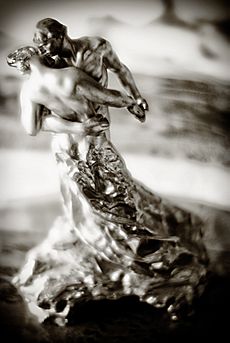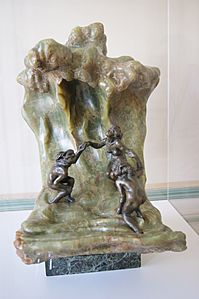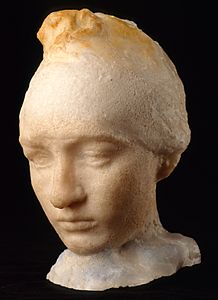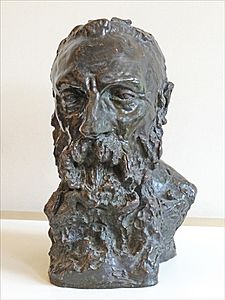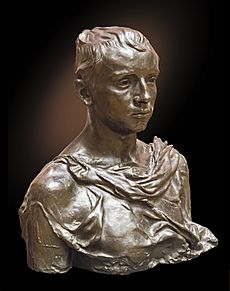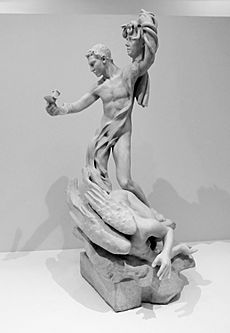Camille Claudel facts for kids
Quick facts for kids
Camille Claudel
|
|
|---|---|

Claudel sometime before 1883
|
|
| Born |
Camille Rosalie Claudel
8 December 1864 |
| Died | 19 October 1943 (aged 78) Montdevergues, Vaucluse, Vichy France
|
| Nationality | French |
| Alma mater | Académie Colarossi |
| Occupation | Sculptor |
| Known for | Figurative artwork in bronze and marble |
|
Notable work
|
Sakuntala The Waltz The Mature Age List of sculptures |
| Relatives | Paul Claudel (brother) |
| Signature | |
 |
|
Camille Rosalie Claudel (French pronunciation: [kamij klodɛl] ; 8 December 1864 – 19 October 1943) was a talented French sculptor. She was known for her amazing sculptures made from bronze and marble. At first, her work was not widely recognized. But later, people began to appreciate her unique style and high quality art.
Camille Claudel created famous sculptures like The Waltz and The Mature Age. Her life and art have been featured in many books and films.
The Camille Claudel Museum opened in 2017 in Nogent-sur-Seine, France. It is a national museum dedicated to her work. Camille Claudel also worked closely with the famous sculptor Auguste Rodin. The Musée Rodin in Paris has a special room just for her sculptures.
Her artworks are also displayed in major museums around the world. These include the Musée d'Orsay in Paris, the Courtauld Institute of Art in London, and the National Museum of Women in the Arts in Washington, D.C.
Contents
Early Life & Artistic Beginnings
Camille Claudel was born in Fère-en-Tardenois, France, in 1864. She was the first child in her family. Her father, Louis-Prosper Claudel, worked in banking. Her mother, Louise-Athanaïse Cécile Cerveaux, came from a family of farmers.
The family moved several times during Camille's childhood. They spent summers in Villeneuve-sur-Fère, and the landscape there deeply influenced her. From ages 5 to 12, Camille was taught by the Sisters of Christian Doctrine.
When Camille was 12 and living in Nogent-sur-Seine, she started sculpting with local clay. She often sculpted human figures. As she grew up, she also studied literature and old art prints to improve her artistic knowledge.
Camille's mother did not like her desire to be an artist. She thought it was "unladylike." However, her father was more supportive. He showed Camille's sculptures to their artist neighbor, Alfred Boucher. Boucher saw Camille's talent and told her family to support her art studies. In 1881, Camille moved to Montparnasse in Paris with her mother and siblings. Her father stayed behind to support them.
Becoming a Sculptor
Studying Art in Paris
Camille Claudel loved working with stone and clay from a young age. In Paris, she studied at the Académie Colarossi. This was one of the few art schools that allowed female students. She learned from the sculptor Alfred Boucher. Other art schools, like the École des Beaux-Arts, did not accept women at that time.
In 1882, Claudel rented a studio in Paris. She shared it with three British sculptors: Jessie Lipscomb, Emily Fawcett, and Amy Singer. These friends had studied art in London before coming to Paris. Claudel even visited Singer's family in England.
Alfred Boucher was Camille's mentor. He encouraged her and other young sculptors. Boucher even made a sculpture of Camille reading. Later, Camille sculpted a bust of him.
After teaching Camille for over three years, Boucher moved to Florence. Before leaving, he asked Auguste Rodin to take over teaching his students. This is how Rodin and Claudel met. Their artistic partnership soon began.
Working with Auguste Rodin
Camille Claudel began working in Rodin's studio in 1883. She became a source of inspiration for him. She also modeled for his sculptures and became his close friend. After her father passed away, Camille faced financial challenges.
Her early sculptures show her unique imagination and lyrical style. This is clear in her famous work, The Waltz (1893). Art critics recognized Claudel's great talent and unique style. Some even said her work was more powerful than many male artists of her time.
Claudel's small sculpture, La Vague (The Wave) (1897), showed a new style. It had a decorative quality that was different from her earlier, more "heroic" works from her time with Rodin.
Famous Sculptures
The Mature Age and Other Works
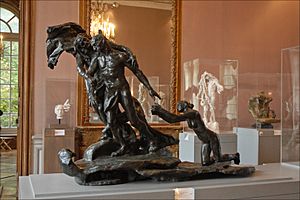
When Rodin first saw Claudel's sculpture The Mature Age in 1899, their relationship became difficult. Rodin stopped supporting her work.
The Mature Age (1900) is often seen as a story about the three stages of life. It shows a man (Maturity) being pulled by an old woman (Old Age and Death). A young woman (Youth) tries to save him. Camille's brother thought it represented her break with Rodin.
Another of Claudel's figures, The Implorer, was made as a separate sculpture. It shows a powerful idea of change in the human experience. It was modeled in 1898 and cast in 1905.
In 1902, Claudel finished a large sculpture called Perseus and the Gorgon. From 1903 onwards, she showed her works at important art exhibitions in Paris.
Sakuntala (1888) is seen as a work where Claudel expressed her own artistic identity. It shows her desire to create art freely, without being limited by Rodin's influence.
There is still discussion about how much Rodin influenced Claudel, and how much credit she received for her work. Many modern experts agree that Camille Claudel was an amazing artist. She started with great potential but faced many challenges.
Camille Claudel also had a connection with the composer Claude Debussy. They both admired artists like Edgar Degas and Hokusai. They also shared an interest in themes of childhood and death. Debussy admired her as a great artist and kept a copy of The Waltz in his studio.
-
Head of Camille Claudel, 1884, by Auguste Rodin, portrays Claudel wearing a Phrygian cap, on exhibit at the Museo Soumaya
Later Life
After 1905, Camille Claudel began to show signs of mental distress. She destroyed many of her sculptures and sometimes disappeared for long periods. She believed Rodin was stealing her ideas and plotting against her. After her brother married in 1906 and moved away, she lived alone in her workshop.
Camille's father had always supported her career. But when he died in 1913, Camille was not told. Eight days later, on March 10, 1913, her younger brother Paul arranged for her to be admitted to a psychiatric hospital.
Records show that while she had emotional outbursts, she was clear-headed when working on her art. Doctors at the hospital tried to convince her family that she did not need to stay there, but they kept her confined.
In 1914, Camille was moved to the Montdevergues Asylum near Avignon. Her admission papers stated she suffered from "persecution delirium."

For a time, the press questioned why such a talented sculptor was confined. Her mother did not allow her to receive letters from anyone except her brother. The hospital staff often suggested that Camille be released, but her mother always refused. Her brother Paul visited her seven times over 30 years. Her sister Louise visited only once. Her mother never visited her.
In 1929, Camille's former friend, sculptor Jessie Lipscomb, visited her. Afterwards, Jessie said it was "not true" that Camille was insane.
Camille Claudel passed away on October 19, 1943, after living 30 years in the asylum. Her brother Paul was informed of her illness and traveled to see her, but he was not there when she died. Her sister did not make the trip.
Camille was buried in the cemetery of Montfavet. Later, her remains were moved to a communal grave at the asylum. This means her bones were mixed with those of other people who had no family to claim them. She never returned to her beloved hometown.
Legacy
Musée Camille Claudel
The Musée Camille Claudel opened in March 2017. It is a French national museum dedicated to Claudel's work. It is located in Nogent-sur-Seine, where she lived as a teenager. The museum displays about half of Claudel's 90 surviving artworks.
Plans to create a museum in the Claudel family home began in 2003. The museum worked with the Claudel family to buy Camille's sculptures. These include 70 pieces, like a bust of Rodin.
Surviving Works
Even though Camille destroyed much of her art, about 90 statues, sketches, and drawings still exist. In 1951, her brother Paul organized an exhibition of her work at the Musée Rodin. The Musée Rodin still displays her sculptures today.
A large exhibition of her works was held in 1984. In 2005, a major art show featuring both Rodin and Claudel's works was displayed in Canada and the US. In 2008, the Musée Rodin held a special exhibition with over 80 of her works.
Camille Claudel's sculptures are highly valued today. For example, in 2005, a version of her sculpture La Valse sold for $932,500. Her art continues to be celebrated and studied around the world.
See also
 In Spanish: Camille Claudel para niños
In Spanish: Camille Claudel para niños
- List of sculptures by Camille Claudel
- Camille Claudel, a 1988 movie about her life, starring Isabelle Adjani and Gérard Depardieu.
- Camille Claudel, a musical from 2003.
- Camille Claudel 1915, a 2013 French movie starring Juliette Binoche as Camille Claudel.
- Rodin, a 2017 film where Izïa Higelin plays Claudel.


